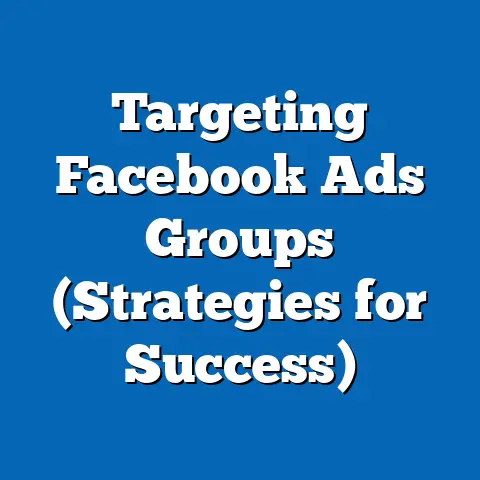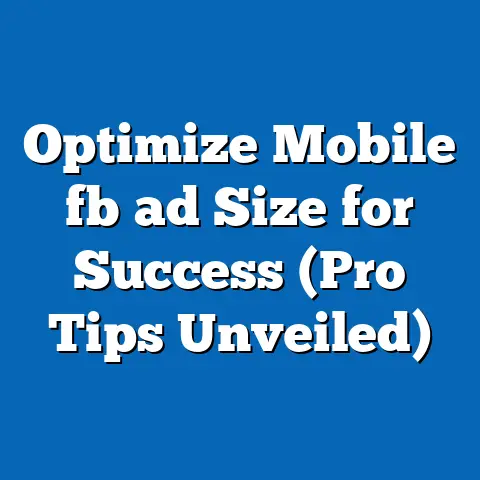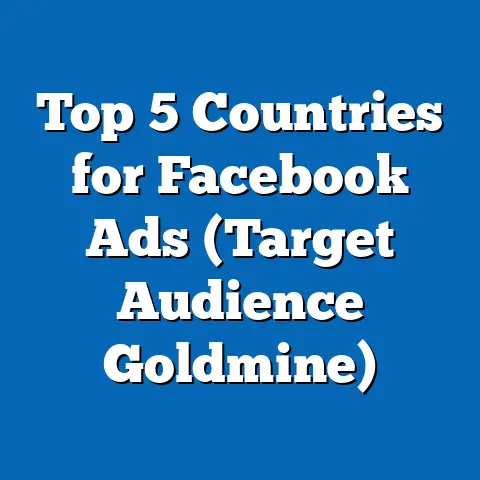Maximize Reach: Can I Use Ads in Facebook Posts? (Expert Insights)
In the ever-evolving world of digital marketing, businesses and content creators are constantly seeking innovative ways to maximize their reach on social media platforms like Facebook. One question that frequently arises is whether incorporating advertisements into organic Facebook posts can effectively expand visibility and engagement. While this strategy holds potential, it also intersects with niche audience preferences, such as pet-friendly choices, which have gained significant traction in recent years due to shifting societal values and generational trends.
Pet-friendly content and marketing resonate deeply with specific demographics, particularly younger generations like Millennials and Gen Z, who prioritize pet ownership and animal welfare. This article begins by exploring the defining characteristics of pet-friendly choices, their historical context, and their broader societal implications. From there, it transitions into a detailed analysis of using ads in Facebook posts, weaving in expert insights and data-driven perspectives to assess the viability of this approach for reaching pet-friendly audiences and beyond.
Part 1: The Rise of Pet-Friendly Choices
Defining Characteristics of Pet-Friendly Choices
Pet-friendly choices encompass a wide range of decisions and behaviors that prioritize the well-being of pets and reflect a commitment to animal welfare. This includes adopting pets from shelters, purchasing eco-friendly and cruelty-free pet products, advocating for pet-inclusive policies in workplaces and public spaces, and creating social media content that celebrates pet ownership. These choices are often driven by a deep emotional bond between pet owners and their animals, viewing pets as family members rather than mere companions.
A key characteristic of pet-friendly choices is their alignment with ethical consumption. Consumers who prioritize pet-friendly options often seek transparency in product sourcing, favoring brands that avoid animal testing and promote sustainability. Additionally, pet-friendly choices extend to lifestyle decisions, such as supporting pet-inclusive housing and travel options, reflecting a broader cultural shift toward inclusivity for animals.
This trend is particularly pronounced among younger generations, who are more likely to integrate pet-friendly values into their purchasing decisions and online engagement. Social media platforms like Facebook have become hubs for pet-related content, with communities forming around shared interests in pet care, training tips, and advocacy. Understanding these characteristics is crucial for marketers aiming to connect with this audience through targeted content and advertising.
Historical Context: How Pet-Friendly Choices Emerged
The rise of pet-friendly choices can be traced to several historical and cultural shifts over the past few decades. In the mid-20th century, pet ownership in Western societies began transitioning from a utilitarian perspective—where animals served specific purposes like guarding or hunting—to a more companion-focused model. This shift was fueled by post-World War II economic prosperity, which allowed more households to afford pet care, and urbanization, which reduced the need for working animals.
By the 1980s and 1990s, the animal rights movement gained momentum, with organizations like PETA raising awareness about ethical treatment of animals. High-profile campaigns against animal testing and factory farming influenced public attitudes, encouraging consumers to prioritize cruelty-free products. During this period, the concept of pets as family members solidified, particularly in the United States, where pet ownership rates soared—reaching 67% of households by 2023, according to the American Pet Products Association (APPA).
The advent of the internet and social media in the 2000s further amplified pet-friendly choices. Platforms like Facebook enabled pet owners to share stories, photos, and videos of their animals, fostering online communities that celebrated pet culture. Viral content, such as memes and influencer accounts featuring pets, normalized the integration of animals into everyday life, while advocacy groups leveraged these platforms to promote adoption and responsible ownership. This historical trajectory underscores how pet-friendly choices evolved from a niche interest to a mainstream value, particularly among younger demographics.
Societal Implications of Pet-Friendly Choices
The growing emphasis on pet-friendly choices has far-reaching implications for society, culture, and the economy. One significant impact is the transformation of consumer markets, with the pet industry experiencing exponential growth. The APPA reported that U.S. pet industry expenditures reached $123.6 billion in 2022, driven by demand for premium pet food, grooming services, and tech-enabled products like GPS collars and pet cameras. This economic boom reflects how pet-friendly choices influence purchasing behavior across generations.
Culturally, pet-friendly choices have reshaped social norms, particularly around inclusivity and empathy. The push for pet-friendly workplaces, housing, and public spaces highlights a broader societal shift toward accommodating diverse lifestyles. For instance, companies like Amazon and Google have implemented pet-friendly office policies, recognizing the mental health benefits of pet companionship—a trend that resonates with Millennials and Gen Z, who often cite pets as sources of emotional support.
However, these shifts also present challenges. The demand for pet-inclusive policies can strain resources, such as housing availability, and raise debates about accessibility for non-pet owners. Additionally, the environmental impact of pet ownership, including the carbon footprint of pet food production, has sparked discussions about sustainability within the pet-friendly movement. These complexities illustrate the nuanced societal implications of pet-friendly choices, which marketers must navigate when targeting this audience.
Part 2: Generational Dynamics and Pet-Friendly Choices
Millennials and Gen Z: Champions of Pet-Friendly Values
Generational trends play a pivotal role in the adoption of pet-friendly choices, with Millennials (born 1981–1996) and Gen Z (born 1997–2012) leading the charge. Millennials, often dubbed the “pet parent” generation, have redefined pet ownership by prioritizing emotional bonds over traditional roles for animals. A 2019 survey by TD Ameritrade found that 67% of Millennials view their pets as “starter children,” reflecting delayed milestones like marriage and parenthood in favor of pet companionship.
Gen Z, shaped by digital connectivity and social activism, takes pet-friendly choices a step further by advocating for systemic change. This cohort is more likely to support shelter adoptions over purchasing from breeders, with 43% of Gen Z pet owners adopting from shelters compared to 34% of Millennials, per a 2022 Rover report. Their engagement with pet-related content on platforms like Facebook is also notably high, as they follow pet influencers and join advocacy groups online.
Both generations share a commitment to ethical consumption, often aligning pet-friendly choices with broader values like sustainability and social justice. However, their approaches differ—Millennials focus on integrating pets into family life, while Gen Z emphasizes activism and community-building. Marketers targeting these groups on Facebook must tailor content to reflect these distinct priorities while leveraging the emotional resonance of pet-friendly messaging.
Boomers and Gen X: A More Practical Perspective
In contrast, Baby Boomers (born 1946–1964) and Generation X (born 1965–1980) exhibit a more pragmatic approach to pet-friendly choices. Boomers, many of whom grew up in an era when pets were often kept outdoors, tend to view pet ownership through a lens of responsibility rather than emotional attachment. While they represent a significant portion of pet owners—owing to higher disposable income—their spending focuses on essential care rather than premium products, according to a 2021 APPA report.
Gen X, caught between traditional and modern pet ownership models, shows a balanced perspective. They value pets as companions but are less likely to advocate for pet-inclusive policies compared to younger generations. Their engagement with pet content on social media is also more passive, often limited to sharing personal photos rather than joining advocacy groups.
These generational differences highlight the diversity within the pet-friendly movement. Marketers using Facebook to reach these audiences must segment campaigns accordingly, balancing emotional storytelling for younger users with practical messaging for older demographics. Understanding these nuances is key to maximizing reach through both organic posts and paid ads.
Part 3: Using Ads in Facebook Posts to Maximize Reach
The Mechanics of Facebook Advertising
Transitioning from the cultural context of pet-friendly choices, let’s explore the practical question at the heart of this article: Can ads in Facebook posts effectively maximize reach? Facebook, with over 2.9 billion monthly active users as of 2023 (Statista), remains a dominant platform for digital marketing. Its advertising ecosystem offers a range of tools, including boosted posts, carousel ads, and video ads, designed to amplify content visibility beyond organic reach.
Boosted posts, in particular, allow users to promote existing organic content to a wider audience by paying for targeted exposure. Unlike traditional ads, boosted posts retain the look and feel of regular content, blending seamlessly into users’ newsfeeds. This format is especially effective for niche topics like pet-friendly choices, as it can target specific demographics—such as pet owners or animal welfare advocates—based on interests, behaviors, and location.
However, using ads in Facebook posts comes with limitations. Organic reach on the platform has declined significantly since algorithm changes in 2018 prioritized personal interactions over branded content. According to Hootsuite, the average organic reach for a Facebook post in 2023 is just 5.2% of a page’s followers, underscoring the need for paid strategies to ensure visibility. While ads can bridge this gap, their success depends on content quality, audience targeting, and budget allocation.
Expert Insights on Effectiveness
Experts in digital marketing offer varied perspectives on the efficacy of using ads in Facebook posts. Sarah Johnson, a social media strategist with over a decade of experience, emphasizes the importance of authenticity when promoting pet-friendly content. “Audiences, especially younger generations, can spot inauthentic messaging a mile away,” she notes. “If you’re boosting a post about pet-friendly products, ensure the content feels genuine—use real pet owners or user-generated content to build trust.”
On the other hand, data analyst Mark Torres highlights the measurable impact of targeted ads. “Facebook’s ad platform provides unparalleled granularity in audience segmentation,” he explains. “For pet-friendly campaigns, you can target users who follow pet pages, engage with animal welfare content, or even own specific breeds. Our data shows a 30% higher click-through rate for hyper-targeted pet ads compared to generic lifestyle campaigns.”
However, not all experts are optimistic about relying solely on paid posts. Digital marketing consultant Emily Chen warns of “ad fatigue,” where overexposure to promoted content can alienate audiences. “Pet owners on Facebook are bombarded with ads for pet products,” she says. “To stand out, brands must pair boosted posts with organic engagement—respond to comments, join pet groups, and share non-promotional content.” These insights underscore the need for a balanced approach when integrating ads into Facebook strategies.
Best Practices for Pet-Friendly Campaigns
For businesses targeting pet-friendly audiences, combining ads with organic content offers a promising path to maximize reach. First, focus on storytelling—create posts that highlight the emotional bond between pets and owners, as this resonates deeply with Millennials and Gen Z. Boosting a video of a rescued pet finding a home, for example, can evoke strong emotional responses and drive engagement.
Second, leverage user-generated content (UGC) to enhance authenticity. Encourage followers to share photos or stories of their pets using a branded hashtag, then boost the best submissions as ads. This approach not only builds community but also reduces the perception of overt selling, a key concern for younger audiences skeptical of traditional advertising.
Third, optimize targeting parameters to reach pet-friendly demographics. Use Facebook’s Audience Insights to identify users with pet-related interests, such as following pet brands or engaging in pet adoption discussions. Tailor ad copy to reflect generational values—for instance, emphasize sustainability for Gen Z or family bonding for Millennials.
Finally, monitor performance metrics closely. Track engagement rates, click-through rates, and cost-per-click to assess the effectiveness of boosted posts. A/B testing different ad formats—such as images versus videos—can also refine strategies over time. By adhering to these best practices, marketers can harness the power of Facebook ads to connect with pet-friendly audiences effectively.
Part 4: Challenges and Ethical Considerations
Navigating Algorithmic and Budgetary Constraints
While using ads in Facebook posts offers significant potential, it also presents challenges. One major hurdle is the platform’s algorithm, which frequently updates and can deprioritize paid content if it lacks engagement. Marketers must continuously adapt to these changes, ensuring that boosted posts encourage likes, comments, and shares to maintain visibility.
Budgetary constraints also pose a challenge, particularly for small businesses or nonprofits in the pet-friendly space. Facebook ad costs have risen in recent years, with the average cost-per-click reaching $1.72 in 2023, according to WordStream. For organizations with limited resources, achieving meaningful reach requires strategic allocation of funds, often at the expense of other marketing channels.
Additionally, over-reliance on paid ads can diminish organic community-building efforts. Pet-friendly audiences value genuine interaction, and excessive promotion can erode trust. Striking a balance between paid and organic content is essential to maintain credibility while maximizing reach.
Ethical Implications of Targeted Advertising
The use of ads in Facebook posts also raises ethical questions, particularly around data privacy and emotional manipulation. Facebook’s targeting capabilities rely on extensive user data, which can feel intrusive to some audiences. Marketers must be transparent about data usage and comply with regulations like the General Data Protection Regulation (GDPR) to avoid backlash.
Moreover, pet-friendly campaigns often leverage emotional storytelling, which can border on exploitation if not handled sensitively. Boosting posts that depict animal suffering to drive donations, for instance, may alienate audiences who perceive such content as manipulative. Ethical marketing requires prioritizing authenticity and respect for both pets and their owners.
These challenges highlight the importance of a thoughtful approach to Facebook advertising. By addressing algorithmic, budgetary, and ethical considerations, marketers can build sustainable campaigns that resonate with pet-friendly audiences without compromising trust.
Part 5: Societal and Workplace Implications of Digital Strategies
Broader Impact on Marketing and Culture
The intersection of pet-friendly choices and digital advertising reflects broader shifts in marketing and cultural norms. As pet ownership continues to rise, brands across industries—from pet care to travel—are adapting their strategies to appeal to this demographic. Facebook ads play a critical role in this adaptation, enabling businesses to reach niche audiences with tailored messaging.
Culturally, the prominence of pet-friendly content on social media reinforces the normalization of pets as family members. Boosted posts and targeted ads amplify this narrative, shaping public perceptions and encouraging pet-inclusive policies in various sectors. This feedback loop between digital marketing and societal values underscores the power of platforms like Facebook to influence cultural trends.
However, the saturation of pet-related ads also risks diluting their impact. As more brands enter this space, standing out requires innovation—whether through interactive content, partnerships with pet influencers, or advocacy-driven campaigns. The long-term societal impact of these strategies will depend on their ability to evolve alongside changing audience expectations.
Workplace Relevance: Engaging Employees and Customers
In the workplace, pet-friendly marketing strategies have implications for both employee engagement and customer relations. Companies that adopt pet-inclusive policies, such as allowing pets in offices, can use Facebook ads to showcase their culture and attract talent from younger generations. A boosted post highlighting a “bring your pet to work” day, for instance, can resonate with Millennials and Gen Z job seekers who prioritize work-life balance.
For customer-facing businesses, pet-friendly campaigns on Facebook can strengthen brand loyalty. Retailers and service providers that promote pet-friendly initiatives—such as pet-safe products or donation drives for shelters—can build emotional connections with consumers. These efforts, amplified through targeted ads, position brands as socially responsible, a key consideration for modern audiences.
The workplace implications of digital strategies extend beyond marketing to internal culture. By aligning social media campaigns with pet-friendly values, companies can foster a sense of purpose among employees, particularly in industries related to animal welfare. This alignment enhances both employee satisfaction and customer trust, creating a virtuous cycle of engagement.
Conclusion: Forward-Looking Insights and Uncertainties
The integration of ads into Facebook posts offers a powerful tool for maximizing reach, particularly for niche audiences like pet-friendly consumers. By understanding the defining characteristics, historical context, and societal implications of pet-friendly choices, marketers can craft campaigns that resonate with diverse generational values. Millennials and Gen Z, with their emphasis on emotional connection and activism, represent key demographics for such content, while older generations like Boomers and Gen X require more practical messaging.
Expert insights reveal that while boosted posts and targeted ads can significantly enhance visibility, their success hinges on authenticity, strategic targeting, and a balance with organic engagement. Challenges such as algorithmic constraints, budgetary limitations, and ethical considerations must be navigated carefully to maintain audience trust. Moreover, the broader societal and workplace implications of these strategies highlight their potential to shape cultural norms and strengthen brand loyalty.
Looking ahead, the effectiveness of using ads in Facebook posts will likely evolve with technological advancements and shifting user behaviors. Emerging features like augmented reality ads or enhanced data analytics may offer new opportunities to engage pet-friendly audiences. However, uncertainties remain—will ad fatigue diminish returns over time? How will privacy regulations impact targeting capabilities? Marketers must stay agile, continuously adapting to these changes while prioritizing genuine connection over pure promotion.
Ultimately, the intersection of pet-friendly choices and digital advertising exemplifies the dynamic interplay between cultural trends and technological innovation. By leveraging Facebook’s advertising tools thoughtfully, businesses can not only maximize reach but also contribute to a more inclusive, pet-friendly society. The path forward requires a commitment to ethical practices, audience understanding, and creative storytelling—an approach that promises both immediate impact and long-term relevance.






